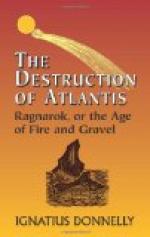But it may be asked:
“Suppose further study should disclose the fact that the Drift is found in Siberia and the rest of Asia, and over all the world, what then? "
It will not disprove my theory. It will simply indicate that the débris did not, as I have supposed, strike the earth instantaneously, but that it continued to fall during twenty-four hours. If the comet was split into fragments, if there was the “Midgard-Serpent” as well as the
{p. 396}
“Fenris Wolf” and “the dog Garm,” they need not necessarily have reached the earth at the same time.
Another says:
“You supposed in your book, ‘Atlantis,’ that the Glacial Age might have been caused by the ridges radiating from Atlantis shutting off the Gulf Stream and preventing the heated waters of the tropics from reaching the northern shores of the world.”
True; and I have no doubt that these ridges did play an important part in producing climatic changes, subsequent to the Drift Age, by their presence or absence, their elevation or depression; but on fuller investigation I find that they are inadequate to account for the colossal phenomena of the Drift itself—the presence of the clay and gravel, the great heat and the tremendous downfall of water.
It may be asked,
“How does your theory account for the removal of great blocks, weighing many tons, for hundreds of miles from their original site?
The answer is plain. We know the power of the ordinary hurricanes of the earth. “The largest trees are uprooted, or have their trunks snapped in two; and few if any of the most massive buildings stand uninjured."[1] If we will remember the excessive heat and the electrical derangements that must have accompanied the Drift Age, we can realize the tremendous winds spoken of in many of the legends. We have but to multiply the hurricane of the West Indies, or the cyclone of the Mississippi Valley, a hundred or a thousand fold, and we shall have power enough to move all the blocks found scattered over the face of the Drift deposits or mixed with its material.
[1. Appletons’ “American Cyclopædia,” vol. ix, p. 80.]
{p. 397}
Another asks:
“How do you account for the fact that this Drift material does not resemble the usual aërolites, which are commonly composed of iron, and unlike the stones of the earth?”
I nave shown that aërolites have fallen that did not contain any iron, and that could not be distinguished from the material native to the earth. And it must be remembered that, while the shining meteoroids that blaze in periodical showers from radiant points in the sky are associated with comets, and are probably lost fragments of comet-tails, these meteoroids do not reach the earth, but are always burned out, far up in our atmosphere, by the friction produced by their motion. The iron aërolite is of different origin. It may be a product of space itself, a condensation of metallic gases. The fact that it reaches the earth without being consumed would seem to indicate that it belongs at a lower level than the meteoric showers, and has, consequently, a less distance to fall and waste.




